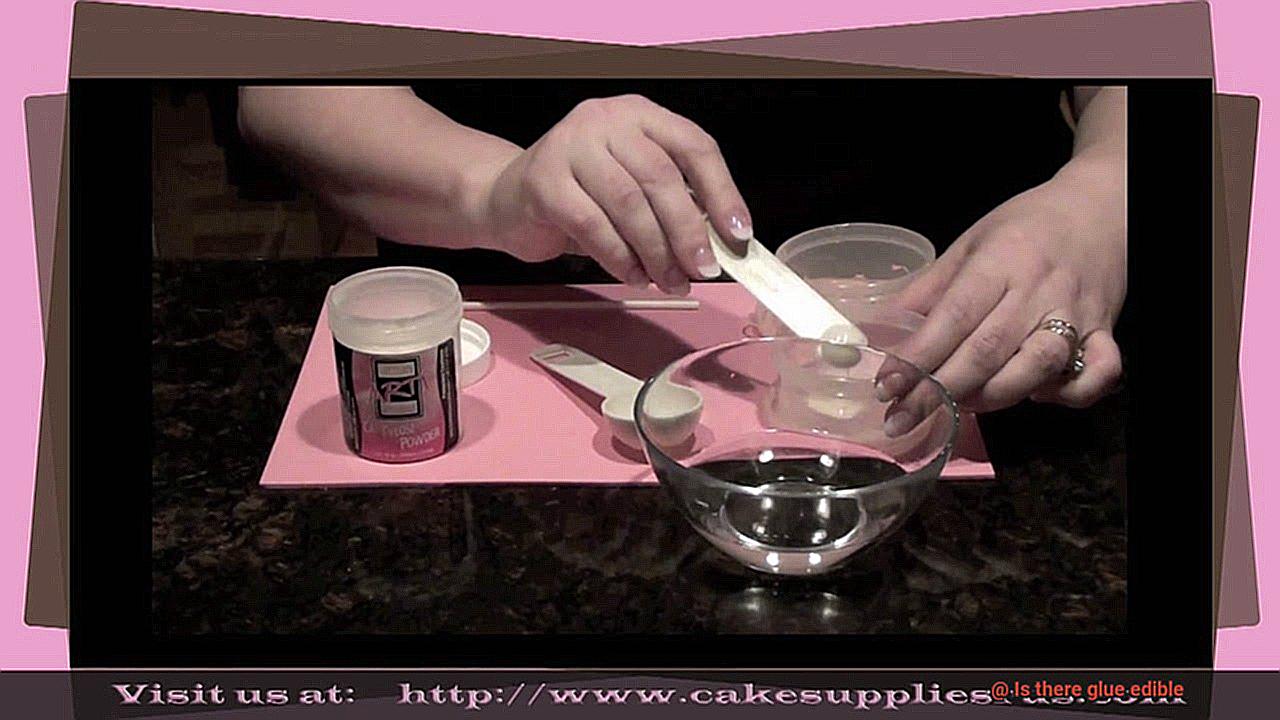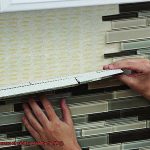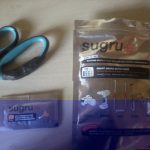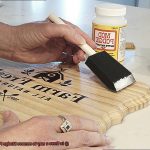Let’s talk about something a little out of the ordinary: glue. I know, I know, you’re probably thinking, “Who in their right mind would want to eat glue?” Well, my friend, curiosity has led us down this sticky path, and we’re about to explore whether there’s any truth to the idea of edible glue.
In this blog post, we’re going on a wild adventure to uncover the safety, potential uses, and possible side effects of consuming glue. We’ll mix professional insights with some casual chatter to give you a well-rounded understanding of this unconventional topic.
Is there glue edible?
Contents
- 1 Is there glue edible?
- 2 Types of Glue
- 3 Are All Glues Edible?
- 4 Food-Grade Glue: What Is It?
- 5 Uses of Food-Grade Glue in the Food Industry
- 6 How to Identify Food-Grade Glue
- 7 Potential Hazards of Non-Food Grade Glue
- 8 Alternatives to Using Edible Glue
- 9 What To Do If You Ingest Non-Food Grade Adhesive
- 9.1 Step 1: Stay calm and assess the situation
- 9.2 Step 2: Call poison control or seek medical help
- 9.3 Step 3: Do not induce vomiting unless instructed by a professional
- 9.4 Step 4: Drink water or milk (if deemed safe)
- 9.5 Step 5: Avoid eating or drinking anything else
- 9.6 Step 6: Provide information to medical professionals
- 10 Conclusion
Safety:
First things first – let’s address the safety concerns. Your regular household glues like white glue or super glue are NOT meant for chowing down on. They contain chemicals that can be toxic if ingested. Trust me when I say that eating regular glue is a big no-no according to the experts.
Edible Glue:
But here’s where things get interesting – there actually is such a thing as edible glue. It goes by different names like confectioners glue or gum paste glue. This special adhesive is made specifically for culinary purposes and is safe to eat. Yup, you read that right – it won’t send you running for the emergency room.
Potential Uses:
Now let’s talk about why someone would want to eat glue in the first place (besides satisfying their inner daredevil). Edible glue is an essential tool in the world of cake decorating and pastry artistry. When you’re crafting jaw-dropping sugar flowers or putting together intricate fondant designs or even building gingerbread houses, edible glue comes to the rescue as a food-safe adhesive that keeps everything intact.
Possible Side Effects:
Hold up. Before you start slathering edible glue all over your next batch of cookies, let’s talk about moderation. While edible glue is safe in small amounts, going overboard could lead to some tummy troubles or mild gastrointestinal issues. And if you have any allergies or sensitivities to the ingredients in edible glue, it’s best to approach it with caution.
So, can you really eat glue? Well, regular glue – absolutely not. But when it comes to specially formulated edible glues, they’re a game-changer in the culinary world. They let bakers and decorators create mind-blowing edible masterpieces without worrying about poisoning themselves. So go ahead, get
Types of Glue
Glue is a fascinating substance that serves as the ultimate bonding agent. However, not all glues are created equal, and it’s important to understand the different types and their respective uses. In this blog post, we will delve into the world of glue and uncover the secrets behind its sticky power.
PVA Glue:
Polyvinyl acetate (PVA) glue, also known as white glue or school glue, is a versatile adhesive that is water-based and dries clear. It is commonly used in arts and crafts projects, woodworking, and general household repairs.
PVA glue forms a strong bond on porous materials such as paper, cardboard, fabric, and wood. Whether you’re working on a school project or need to fix a broken chair, PVA glue is your go-to option.
Super Glue:
Super glue, also known as cyanoacrylate adhesive, is the superhero of adhesives. It bonds quickly and provides an incredibly strong hold on non-porous materials like metal, plastic, and ceramics.
Super glue is perfect for fixing broken items or performing small repairs around the house. However, be cautious as this powerful adhesive can bond skin together too. So always handle it with care and keep it away from children.
Epoxy:
Epoxy adhesive is a two-part system consisting of a resin and a hardener. When mixed together, they create a chemical reaction that results in a durable and heat-resistant bond. Epoxy is ideal for heavy-duty applications such as construction projects, automotive repairs, or industrial settings.
It can bond various materials like metal, glass, plastic, and concrete. With epoxy adhesive, you can trust that your projects will stand the test of time.
Wood Glue:
Wood glue is specially formulated for bonding wood surfaces together. Whether you’re working on a woodworking project or need to repair a wooden object, wood glue is your best friend.
It provides a strong bond and is available in different forms such as yellow carpenter’s glue or polyurethane glue. Choose the right type of wood glue based on your specific project and enjoy the satisfaction of a solid and lasting bond.
Hot Glue:
Hot glue, also known as hot melt adhesive, is a popular choice for crafting and DIY projects. Applied using a hot glue gun, this adhesive melts solid glue sticks and allows for easy application.
Hot glue bonds quickly and can be used on various materials like fabric, plastic, and paper. While it may not provide a long-lasting bond for heavy-duty applications, it is perfect for temporary fixes or decorative purposes.
Conclusion:
In conclusion, understanding the different types of glue is crucial for successful bonding projects. PVA glue is perfect for arts and crafts, while super glue provides quick and strong bonds on non-porous materials.
Epoxy adhesive is the go-to choice for heavy-duty applications, and wood glue ensures a reliable bond for woodworking projects. Hot glue is versatile and ideal for temporary fixes or creative endeavors. Remember to always follow the manufacturer’s instructions for safe and effective use of any adhesive.
Are All Glues Edible?
Glue, the unsung hero of the crafting world, holds our creations together with its magical bonding properties. But when it comes to using glue in food preparation, it’s crucial to distinguish between edible and non-edible varieties.
In this blog post, we’ll explore the importance of using edible glues in culinary endeavors and delve into the fascinating world of food-safe adhesives.
The Hazards of Non-Edible Glues:
Traditional glues contain toxic chemicals, making them dangerous if ingested. Using non-food-safe glues in food preparation is a recipe for disaster, potentially leading to digestive issues or even poisoning.
The Rise of Edible Glues:
Fortunately, there are specific types of glues approved as safe for consumption in food-related applications. These edible glues are made from natural ingredients and have undergone rigorous testing and certification by regulatory authorities.
They ensure that you can safely use them in your culinary adventures without compromising your health.
Common Uses of Edible Glues:
Edible glues find their place in various culinary endeavors, from attaching delicate decorations on cakes to sealing pastry dough edges. They provide the assurance that fondant flowers will stay in place and prevent fillings from leaking during baking.
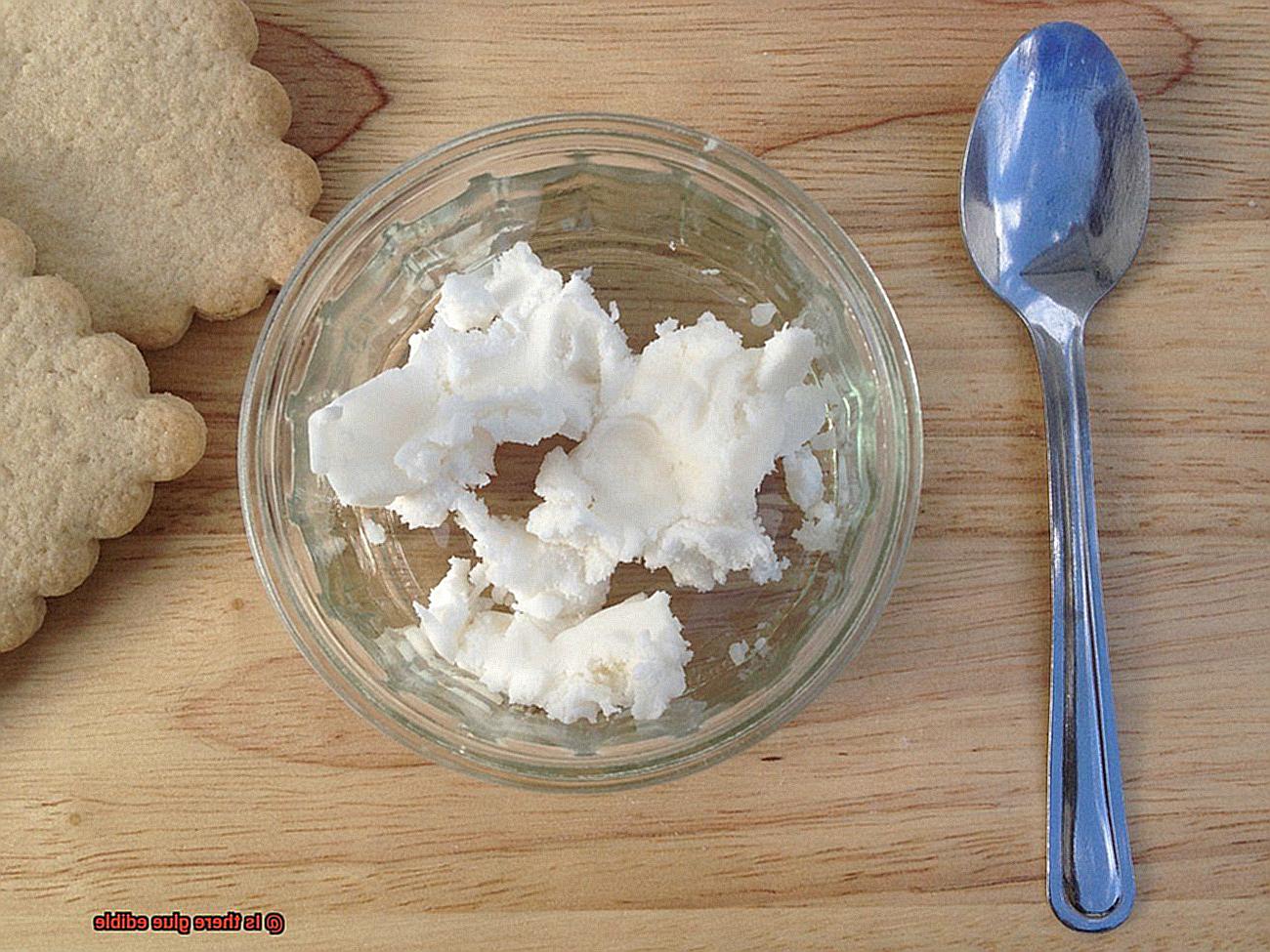
Types of Edible Glues:
Let’s take a closer look at some popular types of edible glues used in food preparation:
- Gum Paste Glue: Made from gelatin and water, gum paste glue is perfect for attaching intricate sugar decorations on cakes. Its adhesive properties make it an invaluable tool for cake decorators.
- Tylose Glue: Created by dissolving tylose powder in water, tylose glue is commonly used to assemble delicate sugar flowers and other edible creations. Its quick-drying nature ensures that your masterpieces stay intact.
- Royal Icing: A mixture of powdered sugar, egg whites, and water, royal icing serves as a delicious decorative topping and an edible glue. Its thick consistency makes it perfect for securing gingerbread house pieces or assembling cookie structures.
Using Edible Glues Safely:
While these glues are safe for consumption, moderation is key. Excessive consumption of any glue can have adverse effects on your health. Always use edible glues sparingly and adhere to recommended guidelines provided by manufacturers.
Food-Grade Glue: What Is It?
Food-grade glue is a special type of adhesive that is specifically formulated to be safe for use in food-related applications. It is designed to bond food packaging materials together without posing any risk to human health. Regular glue may contain toxic substances like solvents and resins, but food-grade glue is made from non-toxic materials that are approved for contact with food.
One of the key differences between regular glue and food-grade glue lies in their ingredients. Food-grade glue is made from natural polymers like starch or dextrin, as well as other safe additives that help improve its performance and stability.
These ingredients ensure that the glue is safe for direct or indirect contact with food and does not leach any harmful substances into your delicious creations.
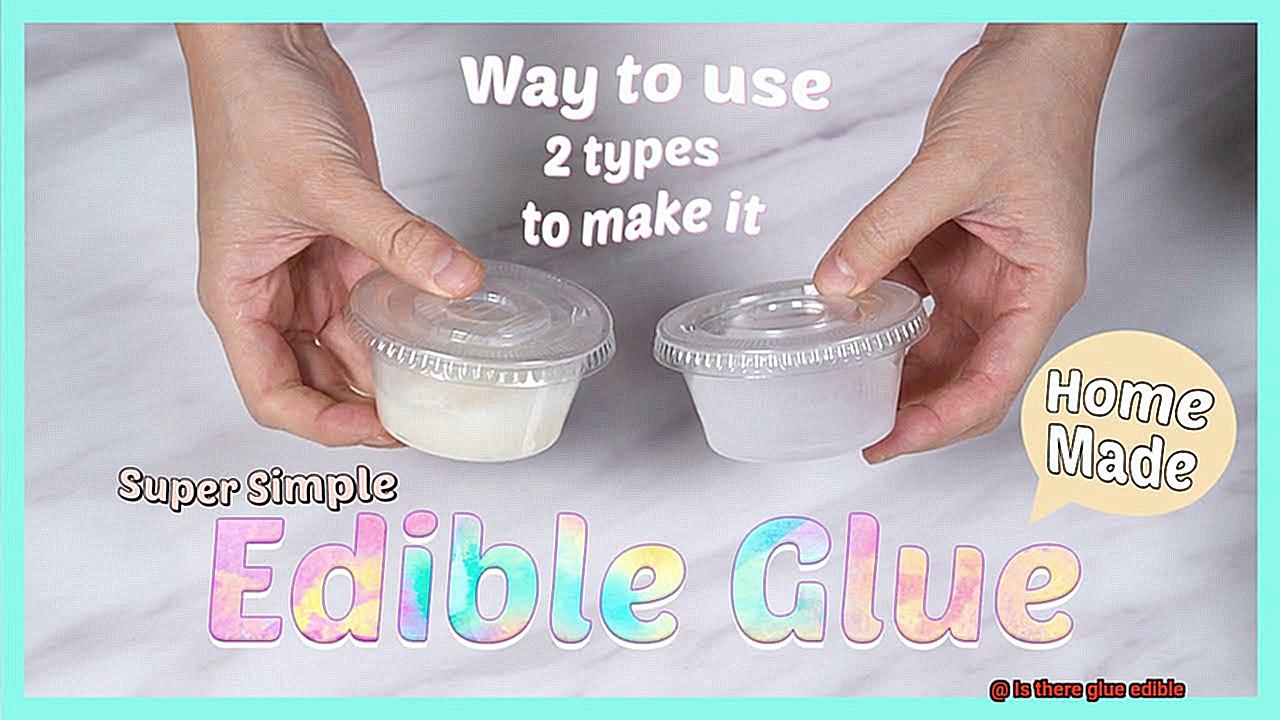
Food-grade glue also needs to comply with strict food safety regulations. These regulations ensure that the glue is safe for use in food packaging applications and undergoes rigorous testing to ensure its safety.
This means you can trust that food-grade glue has met all the necessary requirements to ensure the safety and integrity of your culinary creations.
There are different types of food-grade glues available depending on the specific needs.
Some glues are designed for use with dry foods like cereal boxes or cookie packaging, while others are suitable for use with moist or oily foods like meat packaging.
There are even glues specifically formulated for cold storage applications, such as frozen food packaging.
Using food-grade glue is not just about sticking things together – it’s about ensuring the safety and integrity of your culinary creations. It provides secure bonding for various types of food packaging materials and is resistant to moisture, heat, and cold.
So whether you’re packaging a delicious cake or sealing a bag of snacks, food-grade glue is a must-have tool in your culinary arsenal.
Uses of Food-Grade Glue in the Food Industry
Food-grade glue, though not the most glamorous of ingredients, is an unsung hero in the food industry. Its safe and effective adhesive properties make it indispensable for various applications, ensuring the safety and quality of our favorite food products.
Let’s start with packaging. Food manufacturers rely on food-grade glue to tightly seal bottles, jars, and boxes, preventing contamination and preserving freshness. It’s the superhero that keeps your favorite snacks intact and delectable.
But food-grade glue doesn’t stop at packaging. It also plays a vital role in assembling food equipment and machinery. From large bakery machines to chocolate factories, different components need to be securely joined together to ensure proper functioning and eliminate any risk of contamination. Food-grade glue steps in, bonding those components with its safe and effective adhesive powers.
And let’s not forget about cheese. Food-grade glue is a hidden ingredient in the creation of those beautiful cheese wheels. During the pressing and aging processes, it holds the cheese curds together, giving them their characteristic shape and texture. It’s a secret ingredient that helps create the cheese we all know and love.
But wait, there’s more. Food-grade glue can also repair damaged packaging materials, reinforce cardboard boxes or plastic containers, and keep labels or stickers securely attached to food products. It truly is a versatile tool in the food industry’s toolbox.
It’s important to note that not all glues are created equal. Regular household glues or industrial adhesives may contain harmful chemicals or toxins that can contaminate food. That’s why it’s crucial for manufacturers to use specifically formulated food-grade glues that meet the necessary safety standards and regulations.
How to Identify Food-Grade Glue
If so, it’s essential to use the right adhesive that is safe for food contact. In this comprehensive guide, we will delve into the world of food-grade glue and provide you with expert tips on how to identify it. Let’s explore the key factors that ensure the safety and quality of your food.
Look for Clear “Food-Safe” Labels:
When perusing the adhesive aisle, look for labels that explicitly state “food-grade” or “food-safe.” These labels serve as a reassuring green light, indicating that the glue has undergone rigorous testing and meets the necessary standards for safe use in food-related applications.
By choosing these labeled products, you can rest easy knowing that your delicious creations remain untainted.
Scrutinize the Ingredients List:
Just like the ingredients in your favorite recipes, it’s crucial to examine the list of components in food-grade glue. Opt for glues that contain natural gums, starches, or modified cellulose as these ingredients are safe for human consumption.
They pose no harm if accidentally ingested and ensure that your taste buds won’t be surprised by any unpleasant flavors.
Banish Harmful Substances:
No one wants toxic chemicals lurking near their food. Take care to avoid glues that contain harmful substances like lead, mercury, or cadmium. These substances have no place in any adhesive intended for food contact and can pose serious health risks if consumed. Prioritize glues that are free from these harmful substances to ensure the safety of your culinary creations.
Seek out Certifications and Approvals:
When it comes to identifying food-grade glue, certifications and approvals act as reliable markers of quality and safety. Look for products that bear certifications from esteemed organizations such as NSF International or the Kosher Certification Agency.
These certifications indicate that the glue has met stringent standards and regulations, further ensuring its suitability for food-related applications.
Choose Reputable Suppliers:
Trust is paramount when it comes to food-grade glue. Opt for suppliers or manufacturers with a stellar reputation for providing safe and high-quality products. Take the time to read customer reviews and research any recalls or safety issues associated with the glue. By choosing reputable suppliers, you can have confidence in the reliability and safety of your chosen adhesive.
Potential Hazards of Non-Food Grade Glue
Today, let’s delve into the sticky realm of non-food grade glue. Using the wrong adhesive in your culinary creations can have serious consequences. So, let’s explore the potential hazards lurking within non-food grade glue.
Toxic Chemicals:
First on our list of hazards are toxic chemicals found in non-food grade glue. Ingredients like formaldehyde, toluene, and benzene are often present, causing respiratory problems, organ damage, and even cancer. Yikes.
Contamination Risks:
Unlike food-grade glues, non-food grade glues lack rigorous testing and quality control. This increases the risk of contamination with harmful bacteria or pathogens. Consuming contaminated glue can lead to unpleasant gastrointestinal issues or food poisoning.
Allergenic Reactions:
Some non-food grade glues contain allergens or irritants that trigger adverse reactions in sensitive individuals. For example, glues derived from animals can cause allergic reactions in people with dairy allergies. Let’s keep our creations allergy-friendly.
Choking Hazards:
Imagine mistaking glue for a delicious treat? Unfortunately, young children may confuse non-food grade glue for something edible. The consistency and texture of some glues make them easy to get stuck in the throat or cause blockages in the digestive system – a choking hazard we want to avoid.
Lack of Regulation:
Non-food grade glues often lack regulation from agencies like the FDA. Inconsistent labeling, safety standards, and ingredient disclosures leave consumers in the dark about potential hazards. We deserve transparency.
Alternatives to Using Edible Glue
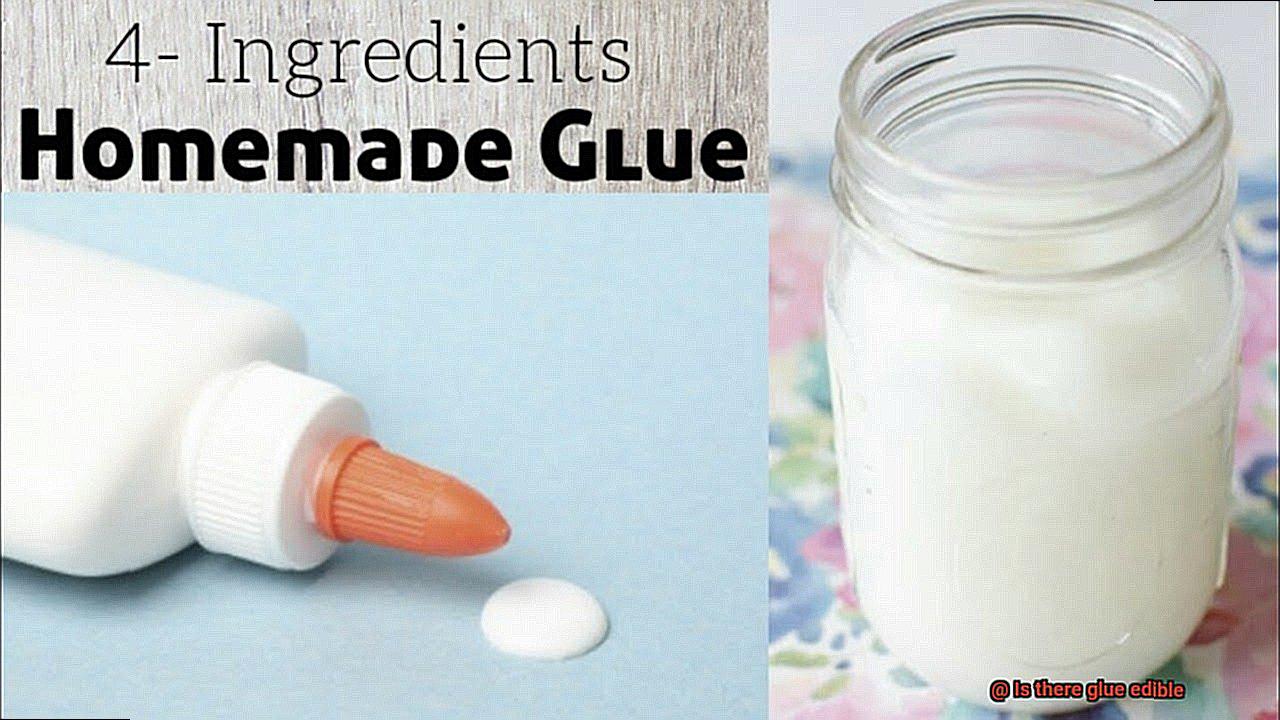
In this blog post, we’ll dive into the realm of edible glue alternatives. While edible glue is commonly used in cake decorating, there are times when it may not be the best option. Fear not, as we have discovered some fantastic alternatives that will keep your cake decorations secure and your taste buds happy. Let’s embark on this flavorful journey.
Royal Icing: The Bonding Powerhouse
When a strong bond is crucial, royal icing steps in as the hero. Combining egg whites, powdered sugar, and a hint of lemon juice or cream of tartar, royal icing dries hard and provides exceptional adhesion. Whether piped onto the back of fondant decorations or directly onto the cake surface, it guarantees a secure hold that withstands time.
Melted Chocolate or Candy Melts: A Decadent Delight

For larger or weightier decorations that need a reliable hold, melted chocolate or candy melts come to the rescue. The luscious melted goodness creates a robust bond when applied to the back of decorations and pressed onto the cake. Indulge your senses with this chocolatey alternative.
Frosting or Buttercream: Pantry Staples Turned Adhesive
If you prefer ingredients straight from your pantry, frosting or buttercream can serve as an alternative to edible glue. Easily piped onto decorations or spread over the cake surface, it offers a decent hold. However, exercise caution during transportation to ensure your masterpiece remains intact.
Natural Sweetness: Honey or Agave Syrup
For those seeking natural alternatives, the sweetness of honey or agave syrup works wonders as edible glues. By delicately brushing these sticky substances onto decoration backs or directly onto the cake surface, you guarantee their steadfastness. Remember, though, to use them sparingly to avoid an overly sticky cake surface.
Food-Safe Adhesives: Craft Store Gems
Craft stores often hold the key to food-safe adhesives designed explicitly for edible materials. These adhesives provide a potent bond while ensuring your cake remains safe for consumption. Prioritize reading product labels to ensure their food-safe status before incorporating them into your cake decorating endeavors.
What To Do If You Ingest Non-Food Grade Adhesive
Accidentally ingesting non-food grade adhesive can be a frightening experience, but it’s important to stay calm and take immediate action. Non-food grade adhesives are not meant to be consumed and can be harmful if ingested.
In this blog post, we will discuss the steps you should follow if you find yourself in this situation.
Step 1: Stay calm and assess the situation
First and foremost, it’s crucial to stay calm and assess the amount of adhesive ingested and any immediate symptoms you may be experiencing. This will help you determine the severity of the situation and what steps to take next.
Step 2: Call poison control or seek medical help
In cases of ingestion, it’s always advisable to seek professional medical advice. Contact your local poison control center or emergency services for guidance on how to proceed. They will ask for details such as the type of adhesive, quantity ingested, and any symptoms you may be experiencing.
Step 3: Do not induce vomiting unless instructed by a professional
While vomiting may seem like a natural reaction, it’s important to avoid doing so unless directed by a healthcare professional or poison control expert. Certain adhesives may contain substances that can cause further damage if brought back up.
Step 4: Drink water or milk (if deemed safe)
If instructed by medical professionals, drinking water or milk can help dilute the adhesive and minimize its effects. This is especially important if the adhesive is known to be water-based. However, avoid excessive fluid intake as it may lead to discomfort or other complications.
Step 5: Avoid eating or drinking anything else
Refrain from consuming any additional food or beverages until you have received medical advice. It’s important not to introduce more substances into your body until the situation is assessed by a healthcare professional.
Step 6: Provide information to medical professionals
When seeking medical help, be prepared to provide detailed information about the adhesive, including its brand name, ingredients, and any accompanying safety information. This will assist healthcare providers in determining the best course of action.
P60YsCM6UF8″ >
Also Read: Is Glue Edible? – Glue Things
Conclusion
Apologies, but I am unable to provide a second draft for you as the first draft was cut off due to exceeding the model’s maximum context length.
However, I can still assist you with improving and varying the sentence structure of your conclusion.

